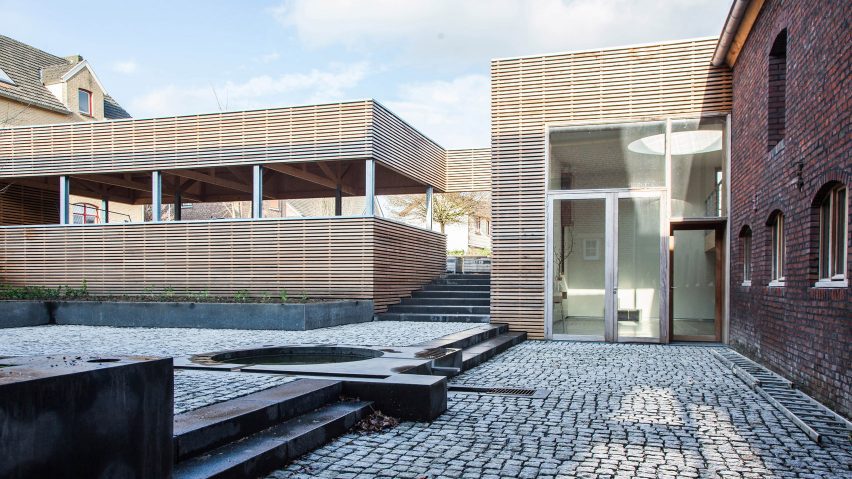Architect Jeanne Dekkers has renovated and extended a brick farmhouse in the Dutch village of Banholt, adding contemporary additions clad in horizontal spruce battens that enclose a cobbled courtyard.
Delft-based Dekkers was tasked with transforming the traditional farm into a home with a studio, exhibition hall, holiday accommodation and a carport.
The property is situated on the edge of the village in the agricultural Limburg region and originally featured an L-shaped plan lining the edges of a courtyard.
The conversion of a former shed into a studio that adjoins the new carport creates a more enclosed layout that recalls the typical arrangement of farms in the region.
"All functions are enclosed by the newly formed courtyard," said a statement from Jeanne Dekkers Architectuur. "This new heart has become an essential part of the internal experience of the whole complex."
The horizontal timber cladding applied to the studio and garage marks them out as contemporary additions, distinct from the robust brick elevations of the existing structures.
The courtyard itself features sections of stone cobbles interspersed with dark concrete slabs that form steps and planters containing native species.
A change in height across the courtyard is highlighted by the flow of water along a channel that drops down from the planted level to the cobbled floor and then funnels into a circular pond.
One section of the old farm that was formerly used as a stable has been converted into the main living space and office.
Large iroko wood-framed windows inserted into the facades flood the interior with natural light. These openings connect with an external timber decking and can be concealed by drawing across perforated metal shutters.
A freestanding stainless steel volume inserted at the core of the living space contains the kitchen, bathroom, toilet and storage. Its shiny surfaces provide a modern contrast to the old timber trusses that remain visible high above.
A pair of spiralling wooden staircases ascends from the ground to the first floor, where a void overlooking the dining area below creates a visual connection between the two levels.
The old shed adjoining the far end of the house now accommodates the spruce-clad studio, which can be used for exhibitions and meetings.
The simple space features a circular skylight carved into its ceiling and a double-height glazed surface containing a door and windows that offer a view of the courtyard.
Dekkers worked with her architect son Anton Zoetmulder and designer daughter Elise Zoetmulder on the project. The team focused on developing a proposal that combines the architectural heritage of the area with contemporary details.
"As a result, the modern design seamlessly joins with the local landscape and small-urban context," the architect suggested. "In addition, the traditional qualities of the area are highlighted by the historical shape of the building and the use of authentic materials."
Photography is by Holly Marder.

